Sig P320 Nitron Carry Vs Beretta Apx Review
I may non like Glock handguns, at least not as much as I like 1911s and magnum revolvers, but I've got to hand it to Gaston. His polymer pistols are some of the best on the market place if simply because of their reliability, concealability, ammo capacity, and toll. If he never made these handguns, there probably wouldn't exist a lot of polymer handguns on the market place today.
Non likewise long ago, one of my friends purchased a Kimber 1911 in .45 ACP for a niggling under $900. He never struck me every bit someone who's into firearms (at least not as much as I am) so I was a little surprised when he told me nigh the purchase.
It makes sense though — he'southward in the healthcare industry and from fourth dimension to time has to piece of work night shifts so he needs a adept CCW for his own security.
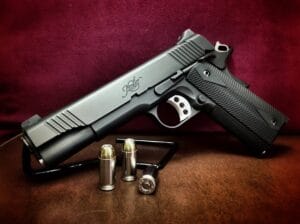 He sounded very pleased with his new conquering and because of it, he might have developed that blazon of crawling to buy more guns (which I'm sure virtually gun nuts out in that location have felt at one point, at least). So he told me that he saw a relatively new Beretta handgun called the APX. He said he finds it especially appealing because information technology looks cool.
He sounded very pleased with his new conquering and because of it, he might have developed that blazon of crawling to buy more guns (which I'm sure virtually gun nuts out in that location have felt at one point, at least). So he told me that he saw a relatively new Beretta handgun called the APX. He said he finds it especially appealing because information technology looks cool.
Knowing adjacent to zilch about this new handgun (I only take the supposition that it was manufactured by Beretta so it must be good), I immediately looked information technology upward on Google images. He was correct, this handgun is oozing with aesthetic appeal, peculiarly for one with a polymer frame. I got curious — could this be better than the Glock 19, its chief competitor?
Luckily, another friend of ours was willing to lend his Beretta APX for us to scrutinize.
If you're looking to purchase this new loftier-chapters polymer handgun from Beretta simply y'all're too lazy to do your ain enquiry, feel costless to read through the entirety of this article. Mayhap you'll find helpful info to assist you lot decide on your purchase.
Table of Contents
- 1 The Beretta APX
- ii What's in the box
- 3 Those Slide Serrations
- four Factory Sights
- 5 Barrel
- half-dozen Frame and controls
- 7 Grip and backstrap
- 8 Magazine Capacity
- 9 Superb Trigger
- ten Trigger Safety
- ten.1 Trigger Pull
- 10.2 Firing Pivot Cake Safety
- xi Modularity: the name of the game
- 12 Disassembly
- thirteen Price
- 14 Conclusion
The Beretta APX
Originally designed by Beretta in 2016 as their entry into the MHS (modular handgun system) competition last twelvemonth, the APX was built to replace the trusty Beretta M9, the standard issue sidearm of the US armed forces since 1985.
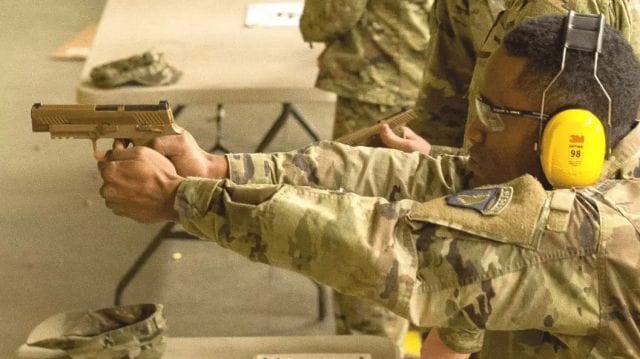
Unfortunately for Beretta, SIG Sauer's P320 concluded up winning the MHS contest, even beating the Glock 19X (much to a lot of Glock fanboys' disappointment), only the contest introduced a lot of great modernistic handgun designs into the marketplace.
Beretta has been in business organization for over five hundred years making actually great quality firearms, and the M9 being the U.s.a. military's standard upshot sidearm for well over three decades is proof. Just the APX is Beretta'due south first accept on striker-fired plastic handguns.
In that location are three variants of this new pistol in terms of size: the total-size APX, which is what we're taking a look at today; the APX Centurion, which is a slightly smaller version Beretta only only recently introduced; and the APX Meaty, the smallest of the three.
Currently, the Beretta APX is only available in two calibers: the ones manufactured in 2016 were chambered for the 9mm, and just a twelvemonth ago the company released the same model chambered in .xl S&W. In this article, we'll just be taking a expect at the Beretta APX in 9mm.
What's in the box
Out of the box, we got three backstraps of different sizes (which we'll talk more almost later) two 17-round magazines, a reloading tool, cleaning brushes and the manual. The Beretta APX is a 17 +1 handgun chambered in 9mm.
Having a polymer frame, it'due south not surprising that our total-size APX only weighs 28 ounces. The handgun's overall length is seven and a half inches.

At present if y'all're familiar with the M9, you'd know that one of the things about Beretta is they manufacture handguns that are fairly thick and heavy, case in point the M92 full-size and even the M92 compact. Those handguns are relatively large compared to other double-stack 9mm handguns.
Considering the size of its older brothers, the APX is really slim, with its slide's width measuring just about ane and a quarter inches. This slim profile makes it a very unique Beretta blueprint. Simply the showtime thing everyone notices right up front end is the diagonal slide serrations, another aspect that makes it unique. And it'south not merely for aesthetics either.
Those Slide Serrations
When I first saw the APX, I didn't know what to make of it. Information technology looked modern, futuristic fifty-fifty, to the signal that I wouldn't accept believed it was from Beretta had I non seen the visitor'southward logo engraved on the slide.
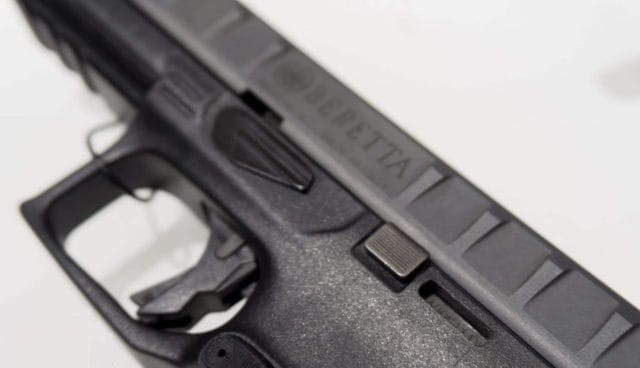
Those serrations spread across the unabridged length of the slide means no matter where I catch information technology, I'm able to rack the slide, unlike my 1911 where I can merely catch the front or rear role of the slide to rack it, or a Glock where only the rear part of the slide has cocking serrations.
I'1000 aware though that there are people who don't similar what Beretta did to the APX'due south slide. I personally don't have issues with the wide serrations, just to each his own. My only gripe about it is whenever my hands are sweaty (I exercise have sweaty palms) and I'm not wearing gloves, I'm having difficulty racking this slide.
All Beretta APX slides are bachelor in Nitron terminate, the aforementioned thing some SIG Sauer models I'thousand enlightened of utilise. I can't find a lot of info online on Beretta's version of Nitron but if information technology'south even remotely as durable as SIG Sauer's (which has a Rockwell hardness rating of 70), information technology will hold up to all only the toughest kinds of abuse.
Manufacturing plant Sights
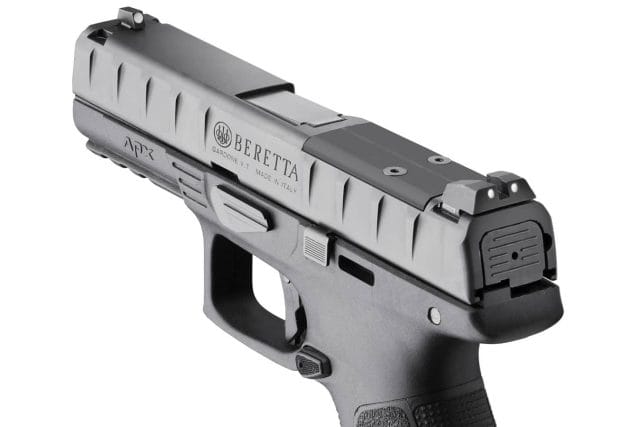 The Beretta APX has stock-still low profile three-dot sights, a bigger front dot and slightly smaller two rear dots which works really well.
The Beretta APX has stock-still low profile three-dot sights, a bigger front dot and slightly smaller two rear dots which works really well.
Different other more pop striker-fired polymer guns that skimp on sights (yep, you know I'grand talking about Glocks), the APX's sights are made of steel. The edges of these steel sights were also rounded a bit, making them snag-free.
They are also dovetailed into the slide for piece of cake removal and reinstallation. Beretta has iv different types of aftermarket sights for the APX on their website : a set up of red fiber optic front with black adjustable rear sights; a set of scarlet cobweb optic front and green fiber optic two-dot adaptable rear sights, a set of three-dot Tritium sights with adjustable rear, and a set of white iii-dot sights with adjustable rear.
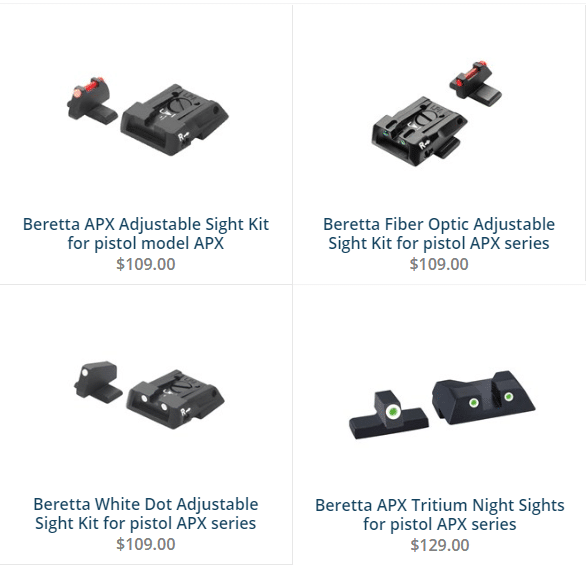
Personally, I wouldn't buy whatsoever of Beretta's aftermarket sights for the APX as they're all quite expensive, with the Tritium set priced at $129 per kit and the rest at $109 per kit. That's highway robbery right in that location — like, practise they really think five of these sight kits are worth a single APX handgun? Bah.
Barrel

The total size Beretta APX uses a link-less barrel design. Information technology has an overall length of iv and a quarter inches, with a right-manus rifling twist length of one in 10 inches.
Nosotros wouldn't say it's exceptionally accurate, merely like almost modern pistol designs, it will easily get the job done, being capable of shooting sub-two-inch groups inside distances of 15 yards fifty-fifty when using cheap factory ammo like Winchester White Box 115 grains.

But once more, like nearly good firearms, information technology volition only be every bit authentic as whoever'due south shooting it. For certain, its relatively depression bore axis of ane and 50-ii hundredths of an inch volition brand firing accurate follow-up shots piece of cake.
But its bore axis measurement isn't anything exceptional (contrary to what a lot of people rave most). For comparison, the Glock 19 has a lower bore centrality (only one and twenty-six hundredths of an inch) which gives the Beretta APX a run for its money every bit far as fast and authentic follow-upwardly shots is concerned.
And if you lot're used to hammer-fired all-steel conventional designs (e.g. the 1911) that point somewhat naturally, you might find it difficult to bespeak whatever handgun with a low diameter axis simply because of you'll accept your index finger positioned from the top curve of the grip's rear to the trigger.
Still, information technology's fairly accurate, easy to do fast and accurate follow-up shots with. Nevermind that Glock has lower bore centrality, the Beretta APX rivals Glocks when information technology comes to reliability, as shown on this video:
One other thing — for people who like messing with their butt'due south forepart, Beretta offers an aftermarket threaded barrel for mounting a suppressor or a compensator on the APX. It's a little on the expensive side though, priced at a cool $219.
Frame and controls

At the front of the Beretta APX'due south frame is a standard 1913 Picatinny rail to attach any of a laser sight or a flashlight.
The handgun has ambidextrous slide stop levers, both very apartment against the surface with just the correct amount of texturing so they tin can be hands actuated even when they're sitting almost flush to the slide.
The depression profile magazine release is easy to actuate and reversible. And it's relatively piece of cake to install on the right side of the frame for left-handed shooters… Hither's a quick video to demonstrate:
The frame comes in 3 different colors: Dark Earth, Olive Drab, and Wolf Gray. Each aftermarket frame comes with two additional sets of backstrap with integrated grip panels. A set of aftermarket grip frame costs $50 from Beretta'due south website .
Grip and backstrap

Beretta designed the APX's grip such that the frame's width tin can be altered by installing any of the included backstraps. This feature is like to that of Gen 4 Glocks, but there'southward a bit of a difference.
Gen 4 Glock backstraps are literally just backstraps. The Beretta APX's backstraps attach pretty much like wrap-around grips, i.e. it has the grip panels integrated. Not that the Gen 4 Glock'due south backstraps are in any way inferior to the Beretta APX — there's hardly any departure every bit far as how both office, but Beretta's version looks cleaner and relatively easier to install.
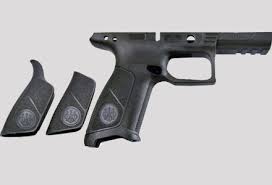 The front end of the grips on our piece likewise accept shallow finger grooves, which I personally like. But I know there are people who don't like it, which is why Beretta released a grip frame with no finger grooves.
The front end of the grips on our piece likewise accept shallow finger grooves, which I personally like. But I know there are people who don't like it, which is why Beretta released a grip frame with no finger grooves.
The grips are shaped to be very ergonomic, they're relatively thin and just fit well in my hand. There'southward square checkering on the back and front of the grips. Information technology'southward non also aggressive, dissimilar the earliest checkering (RTF2) on Glock Gen 3s .
Lastly, loading a new mag in is also made fast and easy thanks to the slightly flared bottom function of the grip, acting as a sort of a magwell. This is some other feature on the grip that makes it really appealing.
Mag Chapters
Every bit mentioned earlier, at that place are 2 included magazines with the Beretta APX, each having a capacity of 17 rounds. These are some really good quality magazines, each with a wide base plate. If for whatever reason, two magazines simply aren't enough for y'all, an aftermarket 17-round mag costs $35 a piece.
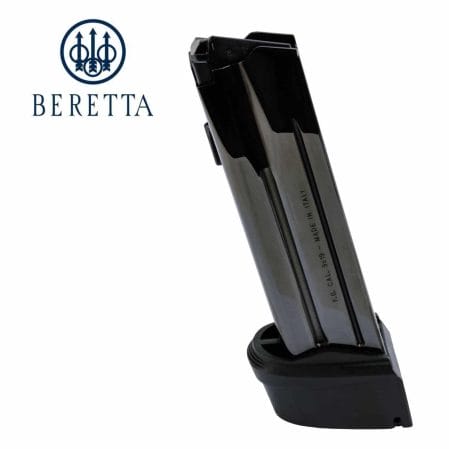
The compact Beretta APX has a 13-circular magazine, with aftermarket ones costing $33 per piece. But if you want more than rounds in your mag, Beretta sells aftermarket 21-circular mags for $36 a piece .
Superb Trigger
There is much to talk about when it comes to the Beretta APX's trigger. The start affair yous'll discover about the pattern of the trigger is the attain of the finger to the trigger's lobe or centrality. The APX allows for a tight purchase with plenty of room for even the shortest of fingers to comfortably pull the trigger.
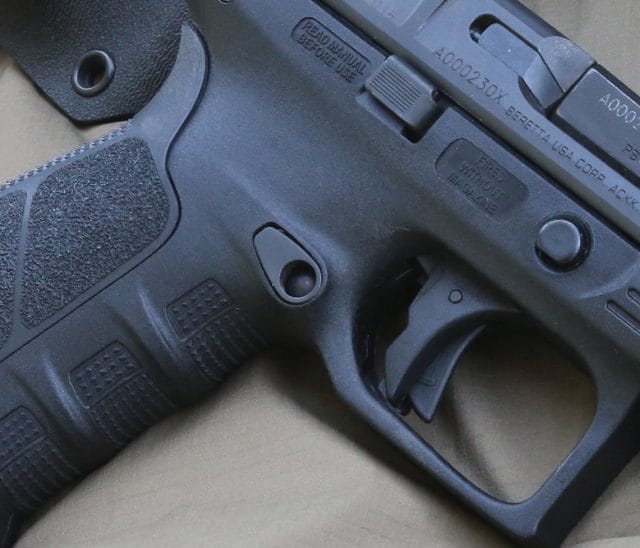
The trigger baby-sit as made to be actually large and broad for users who prefer to clothing gloves. This doesn't come as a surprise every bit the Beretta APX was originally designed primarily as a duty pistol.
Trigger Safety
Right inside the trigger is a little trigger safety lever which looks and feels similar to the typical Glock pistol's trigger safety. When pressed up, information technology relieves that area behind that trigger, allowing for the trigger to be pulled all the way back to fire the pistol.
When that lever inside the trigger is down, the handgun won't burn. This also helps with the driblet prophylactic for the striker inside the gun. And so far, there have been no reports online of any Beretta APX handgun having an accidental discharge, which means this trigger safety works well.

Trigger Pull
Beretta advertises the APX's trigger pull weight to be around 6 pounds. Nosotros tested our loaner gun using our aluminum trigger pull weight guess from Brownell'southward, we got v-pull boilerplate of around 5.8 lbs so ours was within spec.
And almost every bit important as the weight of the pull is the smoothness of the pull. When engaged, as presently as the trigger is pulled, in that location'due south very little resistance all the style to that "wall" of the trigger, i.e. that suspension point in the pull at which the striker is ready to be released.
This trigger is designed to allow the shooter to reach its pause betoken with petty to no resistance at all, which makes fast and accurate follow-up shots easy. At that place are no creeps or bumps before or even after the break signal, resulting in a very clean take up each fourth dimension the trigger is pulled. And the have upwards itself is very smooth once the shooter gets past the break point, with very trivial overtravel.
Beretta actually did their research when they set the trigger pull weight to be around half dozen pounds — once more, not surprising because that its competitors in the MHS competitions mostly take the same trigger pull weight.
A trigger pull weight of half dozen pounds is just strong enough to foreclose adventitious discharges simply low-cal enough to allow for fast and accurate follow-up shots, especially when factoring in the relatively brusk trigger reset of but 3 millimeters.
The trigger has a broad, flat confront which gives a lot of surface allowing for any shooter to be really consistent with each pull.
Firing Pin Block Safety
At the meridian towards the rear of the slide there's a curious looking little piece of steel that is unique to the Beretta APX — and to the Beretta M9 and Model 92. On page 19 of the Beretta APX manual , this little piece is called the firing pin block, which prevents the striker from moving all the style forward if the trigger isn't consummate pulled.

When the trigger is pulled, that niggling slice of steel pops up. If pressure is practical to it, the trigger can't be pulled. We're aware that at that place were people who had concerns with this little firing pin cake push button, specifically those who were thinking they might not be able to install an RMR sight on their APX because it might cake that button, ultimately making the handgun useless.
Beretta addresses this business organisation by releasing their own aftermarket RMR optics mount for the APX, these cost $82 a piece . Note that this doesn't include the optics itself (you'll accept to buy your own). Likewise, the rear sights have to be removed, which means you'll have to bring your APX to a gunsmith to accept this mount installed.
Modularity: the proper name of the game
Perhaps the best feature of the APX is its modularity. Again, this isn't surprising considering Beretta primarily built this handgun every bit their entry to the MHS contest, where i of the many requirements for all handgun entries is to accept modular features that let them adapt different pistol grips, magazine options, and fire control devices.

Each Beretta APX uses a serialized chassis which contains the burn control grouping — the trigger, and the trigger mechanism. Compared to using a serialized frame, a serialized chassis allows for the possessor to speedily and legally switch out frames. Coincidentally (or not), this blueprint concept is the same every bit the modular system found on SIG P320s which, every bit mentioned earlier, ended up winning the MHS contest.
Disassembly
Depending on the user's level of familiarity with handguns in full general, disassembling the Beretta APX can be brutally painful or fairly easy and straightforward. And at that place are ii ways of going almost it.
As with all firearms, the kickoff step e'er is to make sure the gun is unloaded. Simply push the mag release and rack the slide to eject the chambered round, if there'due south any.
The next step required for disassembly is to make certain the striker is deactivated. There are two ways to do this, the first ane is far simpler but requires pulling the trigger, which may result in an unintended discharge if the user failed to eject a chambered round.
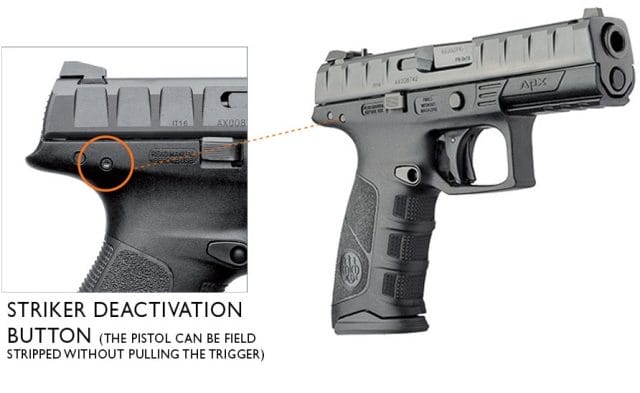
The second option requires applying pressure to that little detent with a dimple on the rear right side of the frame just below the slide. Whatsoever kind of tool can be used to apply pressure to that footling detent. Upon pressing it, the striker is deactivated without the user having to pull the trigger. I personally don't similar doing it this way, as I prefer to disassemble handguns without having to employ whatever kind of tool.
The third stride is to apply pressure on the takedown pin (on the correct side of the frame) with one's left index finger and hold it in, then pull the takedown lever (on the left side of the frame) downwards using one'southward right thumb.
 That takedown pin on the correct side of the frame doesn't accept a whole lot of pressure to undo, but this is the role where some people seem to be having trouble. Non sure why, but I didn't accept problem with the takedown pin/lever on our loaner sample.
That takedown pin on the correct side of the frame doesn't accept a whole lot of pressure to undo, but this is the role where some people seem to be having trouble. Non sure why, but I didn't accept problem with the takedown pin/lever on our loaner sample.
At any rate, as soon as the takedown lever is pulled downwards, the slide is released and easily comes right off. From there the recoil spring guide rod assembly and the link-less barrel can be pulled out of the slide for cleaning and maintenance.
Reassembly is much easier in comparison. Just put the butt in the slide, so put the recoil spring and guide rod assembly back in, then put the slide back on the frame and yank it all the way back with every bit much force equally possible. With enough force, the slide volition disengage the takedown lever. From there the user can but practice a function check.
It all looks complicated in writing so here'south a quick video showing how it'southward supposed to be done:
Price
If y'all go to Beretta's website, the suggested retail price on the APX is $575.00 regardless of the quotient or the ammo capacity of the included magazines you're purchasing.
It's a lilliputian pricey for a polymer handgun especially because that its straight Glock competition, the Glock 19 Gen 5, is just retailing for $559.00 but comes with 3 fifteen-round mags.
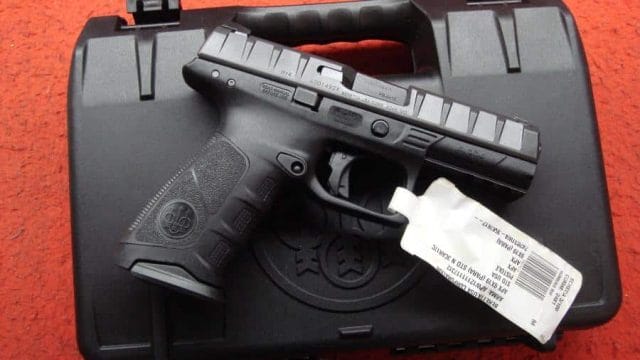
Of class there are online firearm retailers selling information technology for much cheaper — for instance, at the fourth dimension of this writing, Arms Unlimited offering the full size APX Bill for a cool $440, which means a rather meaning 23.47% discount. Simply who knows how many they still take in stock? Discounted units are already out of stock at other online retailers like Botach and DEGuns .
Yet, for a polymer handgun packed with a ton of features and bearing the name of a earth-renowned 500-year-sometime firearms manufacturing company, non to mention its aesthetics and the bragging rights that come with owning a unique looking piece of hardware, the Beretta APX offers great value for the coin.
Decision
Beretta's take on modular polymer handguns is fresh and unique. This is what happens when a visitor really focuses on the things that matter the most to their customers.
The APX is zilch short of impressive. It's reliable, feels practiced in the hands and shoots mighty fast and accurate thanks to its relatively low bore axis and its broad flat trigger with zero creep and quick, short reset. The factory three-dot sights and the low-contour controls but work well. There actually isn't much to say about its many features.
Best of all, information technology ticks all the skilful boxes without sacrificing aesthetics — the same can't be said about Glocks.
While a lot of people think the APX is coming way too tardily to the party (Glock started the polymer handgun revolution more than than iii decades ago), it's prissy to know that an quondam simply well-established firearms manufacturer like Beretta is still doing innovations on their pistol designs.
If yous're in the market for a polymer handgun but you don't similar Glocks and you feel like the SIG P320 is overrated (it might have won the MHS contest only it'due south prone to adventitious discharges ), then we wholeheartedly recommend that yous look into the Beretta APX.
Related Reads:
- All-time Beretta PX4 Storm Compact Holster
- Best Beretta M9 Holster
- Best Beretta 92A1 Holster
- Best Beretta Holsters
- Beretta Nano Holsters
- Beretta Pico Pistol
- The Beretta M9
- Beretta M92FS
- The Beretta PX4
- Best Beretta 92FS Holsters
Source: https://gunnewsdaily.com/beretta-apx-review/
0 Response to "Sig P320 Nitron Carry Vs Beretta Apx Review"
Mag-post ng isang Komento